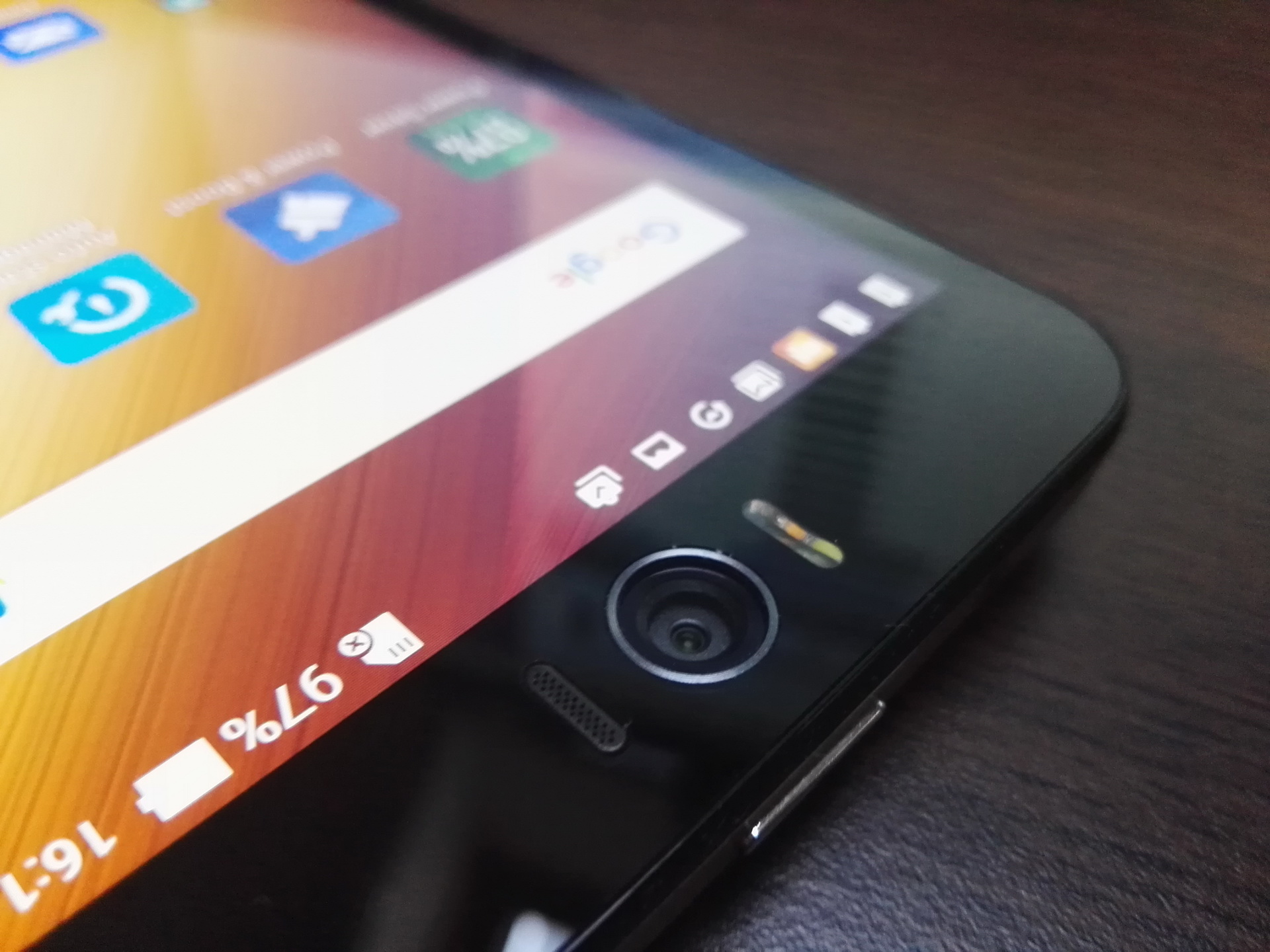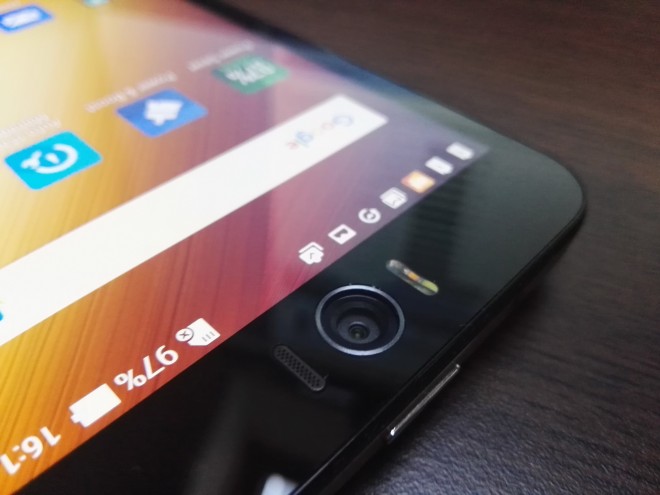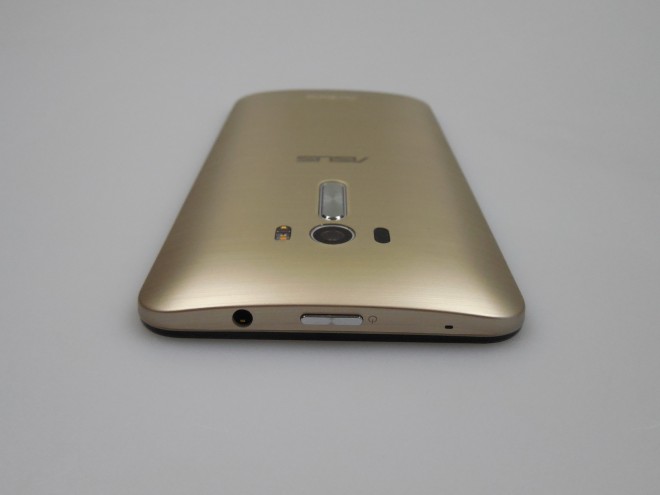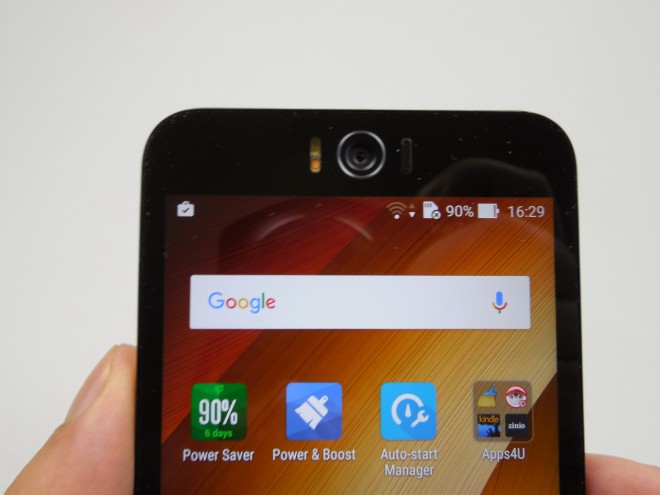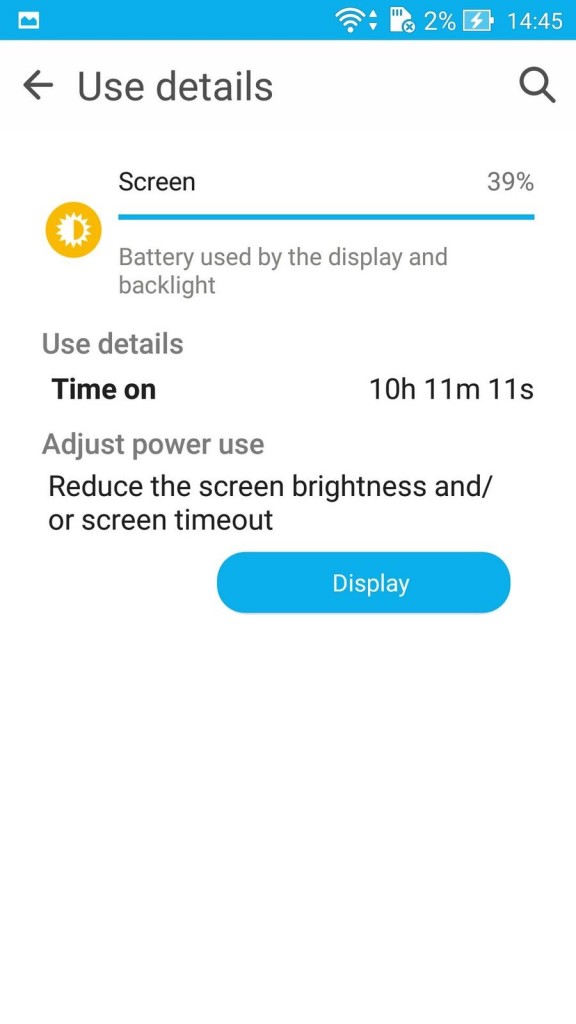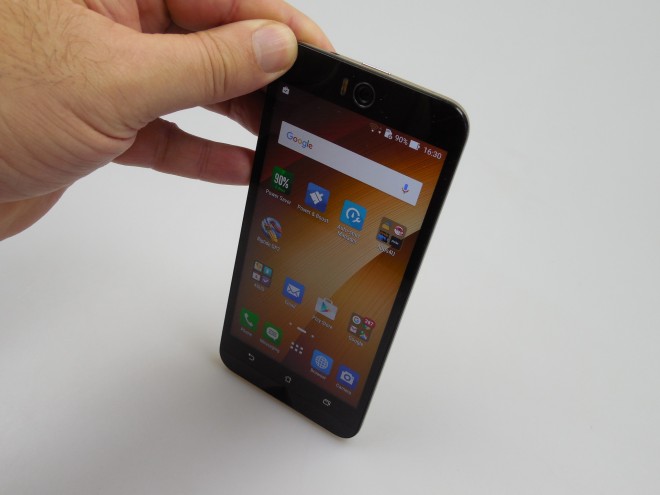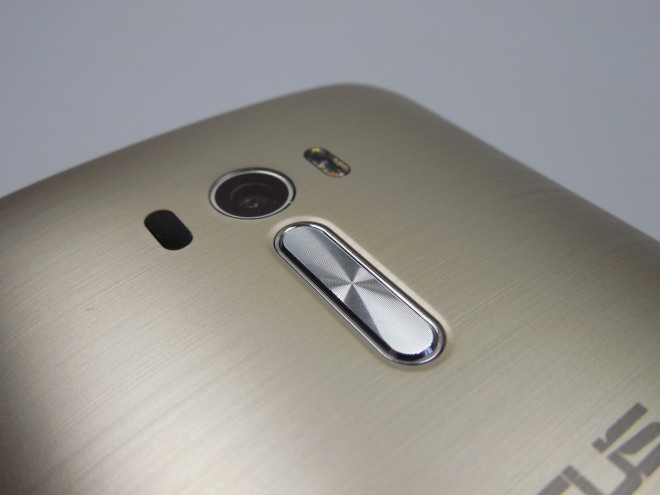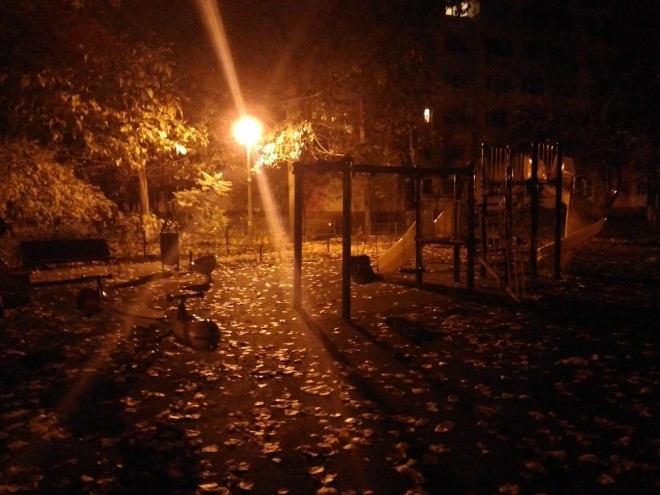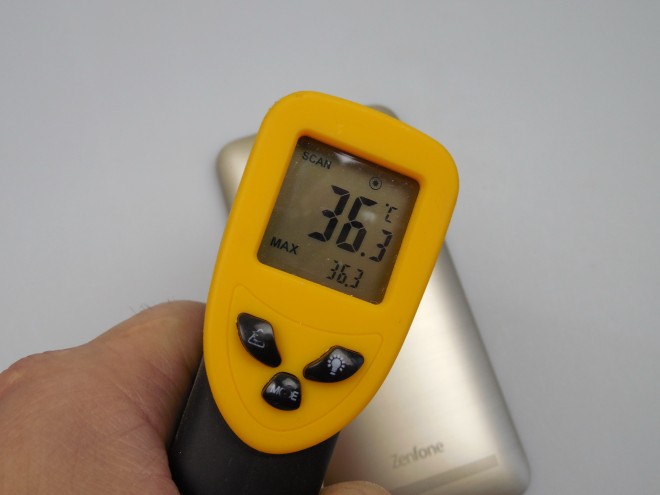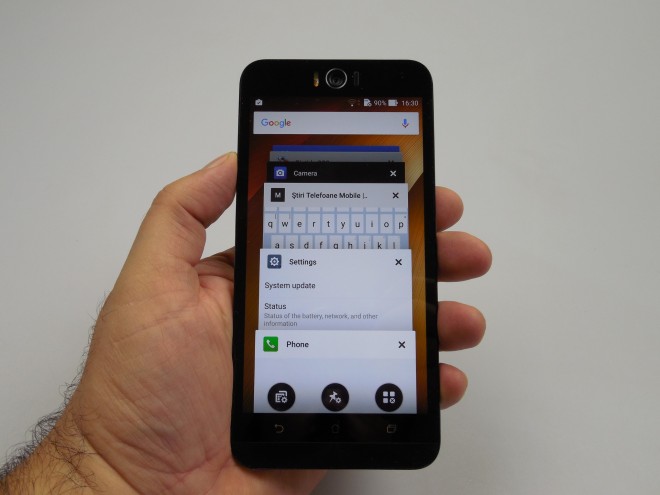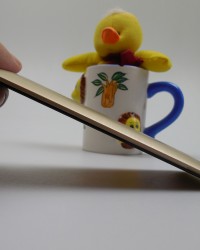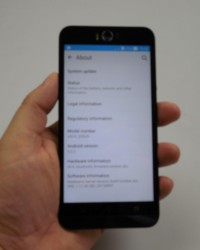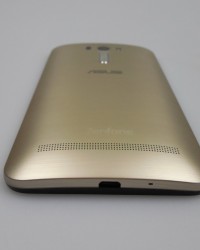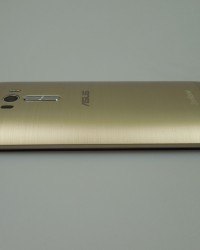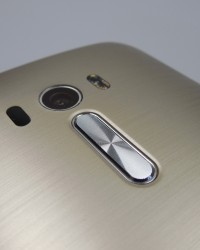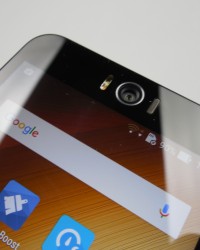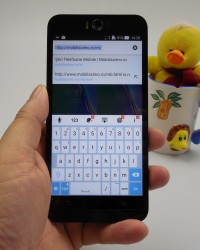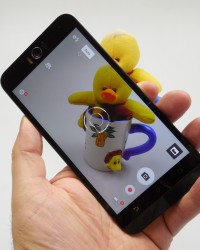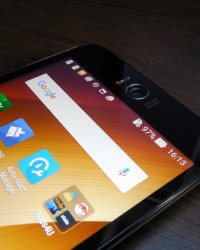After reviewing the ASUS ZenFone 2 and the ASUS ZenFone 2 Laser, it’s time to have a look at the ASUS ZenFone Selfie, in the ZD551KL version. Launched in August, this is the very first selfie-oriented handset we test, unless you count the Xperia M5, but that one also had a high end back camera. ZenFone Selfie is priced at $300 on Amazon and now let’s see what it’s all about.
First of all, it measures 10.8 mm in thickness and weighs 170 grams, keeping the same figures as the ZenFone 2 and ZenFone 2 Laser. It also adopts the same format, with a rounded back and at the very edge this model reaches only 3.9 mm in thickness. It’s got a plastic case, with good grip and it’s pretty easy to use with one hand.
This ZenFone is thicker and heavier than the HTC Desire 820, that weighs 155 grams and measures 7.7 mm in thickness, to put things into perspective. This model comes in black, white, pink, blue, gray or gold and the last color choice is the one we have for testing. This is a comfy handset, that still has big bezels and a solid build.
Upfront there’s the selfie camera with dual LED flash, the earpiece, 3 capacitive buttons and a dotted circular pattern below the screen. At the back we find the main camera, dual LED flash and laser autofocus mechanism, plus the volume buttons, that are comfy to use, but also very noisy when pressed. Also at the back there’s the speaker.
Once the cover is removed (which is quite hard to do) you will discover the dual micro SIM card slots, the microSD slot and a removable battery. The actual speaker is also smaller than expected. ZenFone Selfie has the audio jack at the top and in that same area we find the microphone and the Power button, with Ok feedback.
There’s nothing on the sides and at the bottom you will find the microphone and microUSB port. This ASUS smartphone has a solid and utilitary design, as well as comfy. The back side remains hard to remove and the buttons click in a very loud way. On the hardware side of things, we get a 5.5 inch Full HD screen, with Gorilla Glass 4 protection and an IPS panel.
There’s also an octa core Snapdragon 615 processor in the mix, just like the one on the HTC Desire 820 and ASUS ZenFone Laser and the specs list goes on with the Adreno 405 GPU, 2 or 3 GB of LPDDR3 RAM and 16 or 32 GB of storage. The microSD card slot offers up to 128 GB in extra storage and then there’s 5 GB available via ASUS WebStorage.
Upfront there’s a 13 megapixel camera with dual LED flash and at the back a camera with the very same resolution and also with the same kind of LED flash. Connectivity-wise, the ZenFone Selfie is specced like this: HSPA+, LTE (150 Mbps download speed tops), GPS, Glonass, WiFi 802.11 b/g/n/ac, Bluetooth 4.0 and microUSB 2.0.
This is a dual SIM dual standby device, I’ll remind you that. Its sensors include an accelerometer, G sensor, e compass, gyroscope, proximity sensor, hall sensor and ambient light sensor. The battery here is a Li-Ion 3000 mAh unit, that on paper provides 255 hours of standby or 23.1 hours of talk time. In our test, that involves HD video playback in a loop with WiFi on and brightness at 200 LUX, we achieved 10 hours and 11 minutes.
Thus, we surpassed the Galaxy Note 3 (9 hours and 30 minutes), Galaxy S6 (9 hours and 49 minutes) and Microsoft Lumia 640 XL LTE (9 hours and 49 minutes). Models that did better are: ASUS ZenFone 2 Laser (11 hours and 11 minutes), Galxy S5 (11 hours and 4 minutes) and HTC One M8 (10 hours and 15 minutes). In PCMark, the test that simulates continuous usage we achieved 6 hours and 47 minutes, which is good.
We beat the OnePlus 2 (6 hours and 25 minutes), Sony Xperia M5 (5 hours and 48 minutes) and ASUS ZenFone 2 (5 hours and 45 minutes), but we scored below the Huawei Honor 4X (7 hours and 30 minutes), Galaxy S6 (7 hours and 6 minutes), as well as the Allview E3 Sign (7 hours and 15 minutes). Charging requires 2 hours and 47 minutes for this model and it’s long but within regular limites. It charges faster than HTC Desire 820 (2 hours and 57 minutes), Xperia M5 (3 hours and 4 minutes) and iPhone 6 Plus (3 hours and 6 minutes).
Obviously there are phones that charge faster: Huawei P8 Lite (2 hours and 41 minutes), HTC One M8 (2 hours and 30 minutes) and the iPhone 6 (2 hours and 10 minutes). In the Settings area we find the following Battery modes:
1. Performance: high CPU usage, high brightness
2. Normal: Smart adjust CPU and brightness
3. Power Saving: networks disabled when the device is asleep
4. Super Saving: keep phone, SMS, alarm, disable network
5. Custom: adjust CPU, brightness, network connectivity and extend standby as you please
You can also select what apps can receive notifications in real time. There’s also Smart Switch, that lets you choose a percentage and schedule when a certain power mode will be activated. And then there’s Auto Start Manager, that lets you deny auto start to several power hungry apps. Now that the battery is done and dusted (and it’s very good), we proceed to acoustics.
So, this model has a smaller speaker inside then it looks on the outside. Well, its music player comes with the typical Zen UI, a sleep timer, a color theme option and an equalizer known as Audio Wizard. You can also opt for the stock Android Lollipop EQ, if you want that. Audio Wizard offers options like volume, bass, treble and dialog enhance, as well as a 5 channel equalizer.
The listening experience was loud, clear and crisp with an OK bass and no distorsion. Even on a flat surface, the back speaker would perform OK, thanks the phone’s curved design. Percution was particularly well heard here. Sonic Master technology from ASUS works just fine. The headphones are the same one we’ve seen bundled with the ZenFone 2 Laser, so they’re black, elegant and comfy.
They have a rubber tip, tangling wire and a small remote. This accessory provides a loud sound, great bass, crisp notes and it’s even louder than similar Apple or Samsung products. The FM radio app has a nice UI, a sleep timer, but it doesn’t find radio stations that fast. The Audio Wizard app has its own usage modes: Movie, Music, Gaming, Vocal or Smart, that tweaks certain sound aspects to match your activities.
We did a decibelmeter test and achieved 84.8 dBA at the front and 85.5 dBA at the back, both good results. We surpassed the ASUS ZenFone 2 Laser (85 dBA), iPhone 6 Plus (83.8 dBA), Huawei Honor 6 Plus (82.7 dBA), but scored below the ZenFone 2 (89.1 dBA), LG AKA (86.4 dBA) and Xperia E4G (86.5 dBA). It’s time to have a look at the display now.
ZenFone Selfie offers a 5.5 inch Full HD screen with an IPS LCD panel, Gorilla Glass 4 protection and full screen lamination. The ASUS TruVivid technology involves 2 screen layers instead of 4 and we also get a 72% NTSC color range, plus support for glove input. The phone offers a 403 ppi density, anti fingerprint coating and its video player is the Gallery.
The viewing experience involves cold colors, wide view angles and this screen is clearer and crisper than the 720p screen of the ASUS ZenFone 2 Laser. It’s also not very bright, sadly and it doesn’t offer a great contrast in sunlight. Pixels are of the RGB Stripe kind and the LUX level we measured is 285 LUX units. This year ASUS ZenFone models have had a weak brightness, I have to say.
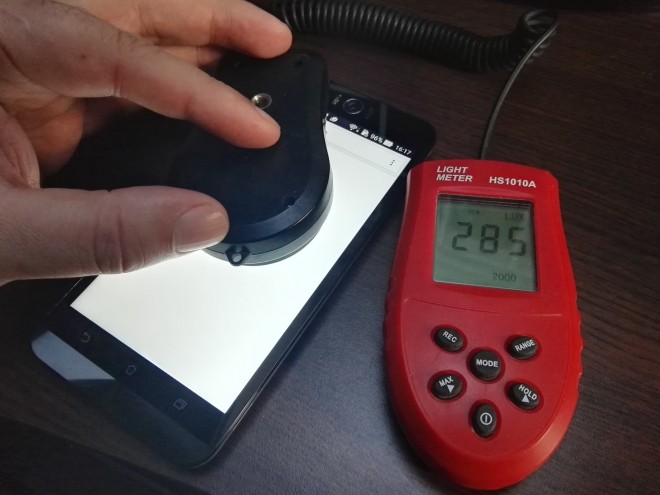
Still, we scored past the ASUS ZenFone 2 Laser (274 LUX), LG G Flex 2 (266 LUX), Sony Xperia E4 (217 LUX), but we got bested by the likes of ASUS ZenFone 2 (323 LUX), HTC Desire 816 (362 LUX) and Sony Xperia Z1 (373 LUX). Display Settings include font style and size and screen color mode, with sub options like Balance, Blue Light Filter, Vivid and Custom (hue and saturation sliders included).
Underwhelming display over and let’s finally have a look at the cameras. At the back there’s a 13 megapixel camera, with F/2.0 aperture and Toshiba sensor, plus blue glass filter and real tone flash. Thanks to the laser focus, this camera can achieve focus in 0.03 seconds. This model uses Pixel Master 2.0 technology and upfront it has a 13 megapixel camera with F/2.2 aperture, 88 degree wide angle view lens, Toshiba sensor, blue glass filter and real tone flash.
ASUS included here a 5 prism largan lens and the laser mechanism on board is used to measure distances efficiently. This handset can easily take 6 cm macros, by the way, according to ASUS. The camera app opens pretty fast and to the left side of the UI we find the flash options, front camera shortcut and settings. Those include white balance ISO (up to 800), exposure, optimization (auto, off or manual with extra options like saturation, contrast, sharpness and more), resolution (13 MP in 4:3 or 10 MP in 16:9), anti shake and image quality (fine or standard).
There’s also Time Stamp, touch shutter, self timer, burst (turbo, fast slow, off) and focus modes (smart autofocus, continunous autofocus or infinity). The list is not over yet, so it includes metering mode (center weighted or average), touch auto exposure, face detection and video options (white balance, exposure, Full/HD resolution, stabilization, smart brightness, guid, anti flicker).
And now we get to the main capture modes: Auto, Manual, HDR, Beautification, Super Resolution, Low Light, Night, Depth of Field, Effect, GIF, Panorama, Miniature, Time Rewind, Smart Remove, All Smiles, Slow Motion and Time Lapse. The Manual mode is certainly most interesting, with extra options like histogram, a leveler, white balance with a Kelvin degree slider, exposure, ISO, shutter speed (from 1/1000 to 32 seconds) and focus (macro to landscape). The shutter speed isn’t half bad, considering LG G has the same option between 1/6000 and 30 seconds.
The video capture gets pretty much the same options, but only white balance, exposure, ISO and focus. The Beauty mode has features like cheeks thinning, eye enhance, skin softening and blush. The Super Resolution mode takes 52 megapixel captures, by interpolating 4 x 13 megapixel shots. The camera experience includes a very fast focus, fluid zoom and a brightness slider, plus if you keep the screen pressed you will trigger AF/AWB/AE lock. The capture speed is so-so.
The front camera has pretty much the same settings and options and the same modes, plus selfie panorama. The manual mode included here offers a shutter speed from 2 seconds to 1/1000 seconds. The pictures aren’t as clear as those taken with the back camera, though. Focus is less fast than the one of the back camera and the zoom in is slower as well.
The selfie cam can do Full HD video and has a powerful torch feature. Be sure to deactivate the mirror image when doing selfie captures. Now as far as galleries go, we have some selfies first, indoor ones with a strange and artificial feel to them. The yellow indoor lighting was probably the culprit here. The camera also felt that like it was overdoing it with the beauty mode.
Colors and texture of selfies were OK, especially when it came to skin and hair. I also have a feeling this camera is above the 13 MP front shooter of the Xperia M5. The second batch of shots are a bit too white for no reason (also selfies), but more clear and with good texture. As far as the back camera goes, we did indoor shots of burgers, looking slightly blurry, but the colors were realistic and texture was OK.
During the day, we pulled a good HDR, that really highlighted details and didn’t exaggerate with brightness. Focus was excellent, as promised by ASUS, in both closeups and further shots. Selfies in the park had a boost in clarity, once we also found that we can use the Auto mode, not only the Default Beautification (keep that in mind!).
There’s some quality loss when you zoom into shots with the main camera and the panorama was wide and reasonably clear. Its resolution was 9600 x 976 pixels. If you pick a landscape shot we did and zoom into it, you’ll find good details and good hues of blue among other. We also have a nice shot of a faucet with a water drop on top, that shows some excellent focus.
Back to selfies, they had some problems with the clarify of the backgrounds, while the foreground was clear (the human subject). Surprisingly, the front camera took a nice landscape shot when turned around. Super Resolution selfies also looked good, although you should be patient till they’re finished, otherwise they’ll be moved.
Details are great in those shots. I find the main camera shots to be above those of the ASUS ZenFone 2 and very close to the level of the ASUS ZenFone 2 Laser, as well as the Huawei Honor 4X, but below the Huawei Honor 6 Plus. On the other front, the selfie shooter is the best I’ve tested all year, in spite of several complaints of mine.
Video is captured here in Full HD, MP4 format, 30 FPS and with 20 Mbps bitrate. The first video we did was shaky, burnt and not crisp, with the second also being all burnt, but its acoustics and clarity were OK, even when zooming in. The third video was shot with the front camera and it was dark, but clear and had good audio.
The fouth video was again captured with the front cam and it was OK, but dark, while the fifth one registered good clarity, but also some exposure problems. Slow motion clips looked nice, not iPhone 6S nice, but you get the idea. Video 7 saw us zooming into a selfie video, to not so good results. Shaky vids and some image burning also happened in the last two clips.
Even with all of these problems, the video capture is still above the HTC Desire 820 and ASUS ZenFone 2, but below the crystal clear vids of the ZenFone 2 Laser. However, I have to note that the front camera doesn’t film half bad. During the night the photo capture was unimpressive till you activated the flash. Huge light halos, some yellow-ish hues were there, but the colors were OK and selfies were fantastic in low light. Natural skin colors really impressed me.
Selfies even looked good without a flash. Night time clips were yellow and blurry, but once again the front camera caught a good one. Overall, the ZenFone Selfie delivers what ASUS promised and it beats the front cam quality of the Xperia M5. The main camera is good for a midranger going for $300 and has great focus. Shaky and burnt videos are the only thing to look out for.
Editing is done in couple of manners, including collages and HTC Zoe-like videos in MiniMovie. Then there are the editing options for faces and those for regular shots, with frames, crop, filters and more. We move on to temperature, having scored 36.3 degrees Celsius, after playing the game Riptide GP2 for 15 minutes, so there’s no overheating here.
The web browser comes with features like Speed Dial, Most Visited, Save and Trending Searches and it’s sadly not that fast. The virtual keyboard has a numeric row, it’s well spaced, comfy and has Swype, so what’s not to like? On the connectivity front, there’s Smart Dial, Speed Dial, Block List, Call Recording and the call quality is good, calls are loud and clear, plus we also have LTE and two SIMs.
Benchmarks were done comparing this model with very similar phones. The ZenFone Selfie took on the ZenFone 2 Laser, HTC Desire 820 and Xiaomi Mi 4i. All 4 of them have Snapdragon 615 processors and 2 GB of RAM, minus the Zenfone Selfie, that has 3 GB of RAM. Here are the results:
Somehow, the ZenFone Selfie only won 1 out of 12 tests, which is poor because other models have less RAM. There’s no lag here, aside from the initally long boot sequence and some slight bumps when performing dozens of updates. Riptide GP2 and other games run just fine. Now let’s address the OS and UI. We’re running on a combo of Android 5.0.2 with ZenUI, colorful and flat, with a carousel multitasking and screen pinning in the mix.
There are ton of updates to perform to the ton of apps installed and the boot is very long. If you keep the Homescreen pressed you’ll access the Manage Home area, where you can manage the widgets, homescreens, wallpapers, icon packs, app layout, scroll effects, lock apps and preferences. Widgets are good looking and useful, particularly those related to ASUS’s own apps.
The UI is fluid and in the dropdown area we find the bubble-looking Quick Settings and notifications. Settings include ZenMotion (gestures like double tap to activate screen and draw symbols to trigger apps), one hand usage, Do Not Disturb, ASUS Cover, ASUS Custom Settings, Easy Mode and security functions. The preinstalled app list is huge, but at least the system knows exactly in which custom folders to place your apps.
Here’s the list:
Clean Master
Dr Safety
Amazon Kindle
Free Games
Trip Advisor
Contacts
Email
Messaging
Phone
Puffin
Google Chrome
Gmail
Maps
YouTube
Drive
Play Music
Hangouts
Photos
FM Radio
Music
Camera
Gallery
Photo Collage
Browser
Calculator
Calendar
Do It Later
Share Link
Flash Light
What’s Next
Webstorage
Docs
Slides
Sheets
ZenCircle
ZenTalk
ASUS Mobile Manager
ASUS Support
Audio Wizard
Auto Start Manager
Backup
Clock
File Manager
Mirror
PC Link
Power Saver
Quick Memo
Remote Link
Setup Wizard
Sound Recorder
Splendid
Supernote
System Update
Data Transfer
Downloads
Google Settings
Play Store
Settings
Voice Search
Kids Mode
Laser Ruler
Mini Movie
My ASUS
Weather
Themes
Zinio
Omlet Chat
Play Games
Do It Later and What’s Next are the most interesting apps here, serving the role of soon to do timeline and a calendar for the next days, with VIP contacts and weather included. SuperNote has also evolved into a very beefed up Samsung S Note rival, with tons of features. And now let’s see the verdict.
Here are the Pros:
good battery
good price
lots of battery saving modes
great headphones
good acoustics
lots of camera modes
great focus speed
very good selfies
OK back camera for price
And the Cons:
hard to remove back cover
loud buttons
display not very bright
video capture below photo capture quality
not so good benchmarks
bloatware
long boot
This is certainly an ego stroking tool, a handset for selfie maniacs, even able to take good selfies at night, but does it do anything else? For starters, it has great acoustics and battery, so it’s a good music phone, but not a very good movie phone, on account of the screen’s brightness. It’s affordable and has a decent back camera too, but it doesn’t shoot video in a very impressive manner.
Still, selfie crazed people should buy this handset, at least in favour of the Xperia M5, that we didn’t like as much when using the front camera.

